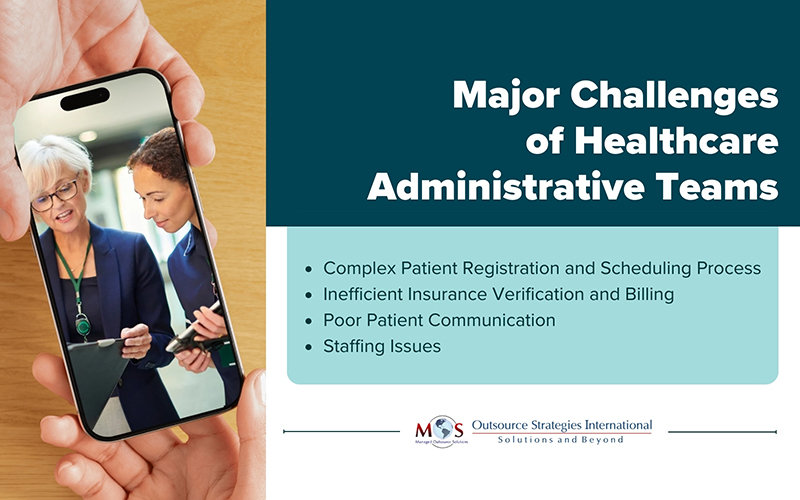It’s a common scenario – on a busy morning at your practice, there’s a long line of patients at the front desk, and the phone rings constantly with urgent inquiries. Suddenly, a scheduling error results in an upset patient, and another arrives late for their appointment. Amid this chaos, the front desk team struggles to juggle multiple tasks at once, leading to frustrated patients and stressed out employees. With the right strategies in place, front desk challenges in medical practices can be efficiently handled to improve both operational flow and patient satisfaction.
In any medical practice, the front desk office usually serves as the first point of interaction between patients and their providers. Receptionists, administrative assistants, insurance verification specialists, and office managers work together to create a seamless patient experience. However, front desk management in healthcare comes with both predictable and unexpected challenges, which must be addressed efficiently while ensuring a welcoming environment.
Efficient front desk management is critical to the revenue cycle—and that’s where a medical billing company becomes a valuable partner. From helping with patient scheduling and verifying insurance to collecting copays, and gathering accurate demographic and insurance data, and more, a reliable company ensure that the practice front desk is not only patient-friendly but also revenue-smart.
What Are the Typical Processes in a Clinic Front Office?
The administrative team wears many hats, from scheduling appointments and managing patient intake forms to verifying insurance information and coordinating communication between providers and patients. Inefficient handling of front desk responsibilities in medical practices can lead to bottlenecks or issues that impact the overall experience. By maintaining the flow of these tasks and anticipating potential problems, practices can minimize disruption and maintain a high level of service.
Tired of administrative headaches?
Discover how our outsourcing experts can transform your practice and maximize efficiency!
Key Challenges Faced by Healthcare Administrative Offices
Running a medical practice’s front office is not an easy task, as it sets the tone for the entire visit. There are several moving parts that need to be handled efficiently from the moment a patient walks in to ensure a smooth patient journey.
Let’s break down some of the most common challenges faced by administrative teams:
- Complex Patient Registration and Scheduling Process
The conventional patient registration and scheduling process is usually one of the major hurdles as it results in long wait times and lengthy paperwork. However, ensuring patients complete the necessary forms and provide accurate information is just the beginning. From there, scheduling becomes a whole new challenge. Appointments must be properly coordinated as managing cancellations, reschedules, and late arrivals can lead to frustration on both ends. Registration and appointment scheduling issues include:
- Incomplete or incorrect patient information
- No arrivals or late arrivals due to scheduling errors
- Overlapping time slots due to absence of intuitive scheduling system
- A lack of standardization in the process for returning patients
- Inefficient Insurance Verification and Billing
Handling insurance verification prior to a patient encounter is a critical but often tedious task. With various insurance policies, checking coverage and eligibility during the patient intake process requires accuracy and attention to detail. Without up-to-date information, practices may end up seeing patients who aren’t covered under their insurance plan, leading to payment delays and billing disputes. Additionally, the sheer amount of paperwork required for insurance claims can lead to errors and administrative delays. Main challenges in insurance verification and billing include:
- Changes or updates in insurance plans that are not communicated properly
- Denied prior authorization and confusion regarding coverage, leading to billing disputes after services are rendered
- Slow verification processes and complex claims that require additional administrative effort and time
- Poor Patient Communication
Effective communication among patients, providers, and administrative teams is the foundation of any healthcare practice. However, during busy periods, it can be difficult for staff to manage incoming calls, emails, and in-person inquiries while also completing other tasks. This may lead to missed messages, delayed responses, late arrivals, and even cancellations, creating downtimes and overcrowded waiting rooms. Key challenges in patient communication include:
- Difficulties in coordinating follow-ups or test results between the administrative team and medical professionals
- Missed patient appointments or late arrivals, leading to dissatisfied patients and damaged reputation
- Multitasking mistakes and inefficient communication channels that result in patients receiving incomplete or contradictory information
- Staffing Issues
An essential aspect of managing staffing at the front desk is balancing the workload to prevent burnout or inefficiency. Understaffing, often resulting from budget constraints or high turnover, can overwhelm the existing team, leading to delays or errors in processes. On the other hand, overstaffing may seem like a solution to alleviate pressure, but it can result in inefficient resource utilization, reduced staff productivity, and unnecessary operational costs. Striking the right balance in staffing levels is essential to ensure the administrative team is adequately equipped to handle multiple tasks while maintaining a calming atmosphere. Some common challenges in staffing include:
- Overworked or unsupported employees can increase the likelihood of errors, burnout, and turnover rates.
- Unbalanced workloads among front desk staff can lead to resource underutilization, inconsistent patient experience, and increased response times.

Key Strategies to Manage the Front Office Effectively
While issues at the front desk of any medical practice are inevitable, with the right tools, strategies, and solutions, administrative teams can mitigate their impact. By identifying key challenges that employees deal with regularly, practices can develop and implement effective strategies to target them. Doing so allows healthcare providers to foster a supportive work environment that delivers superior patient care.
Here are some potential solutions:
- Leverage Technology for Optimized Workflow
Incorporating technology into the front desk operations can significantly reduce staff stress and improve efficiency. Automated scheduling systems, digital forms, and patient portals optimize the entire patient registration and scheduling process, minimizing errors associated with manual data entry. These intuitive systems can eliminate double-booking, and send timely reminders, reducing the chances of no-shows and late arrivals. Similarly, automating insurance verification through software tools allows staff to verify patient eligibility and coverage in real-time, flagging discrepancies immediately. This integration ensures accurate billing, minimizes delays, and prevents surprises, ensuring a smoother experience for both staff and patients.
- Centralized Communication System
To improve patient communication, and minimize disorganized messages, consider implementing a centralized communication system. A centralized network can integrate multiple communication channels, such as phone calls, emails, and text messages, into one platform. By doing so, the staff can respond more promptly and consistently to patient inquiries, appointment changes, and follow-ups. A single, well-organized communication platform with automated responses can help employees handle common inquiries and issues. This enhances collaboration between different departments, simplifying communication processes and ensuring patient concerns are addressed in a timely manner.
- Prioritize Staff Training and Development
Providing effective communication tips for front desk teams can significantly enhance patient interactions, reduce misunderstandings, and improve overall practice efficiency. Healthcare organizations can implement ongoing staff training to ensure the administrative team is equipped with both technical and soft skills. Investing in cross-training programs can also help employees manage multiple roles in case of staff shortage, ensuring that the team is adaptable. Review front office operations regularly based on data-driven insights to pinpoint specific challenges, identify areas of improvement, and develop effective solutions to mitigate them. Tracking peak times, patient volume, and workload will provide information regarding when to schedule additional help or adjust hours for staff. This proactive approach to staffing ensures that there are always enough resources to meet the demands of the practice without incurring unnecessary costs.
Implement Security Measures and Compliance
Ensuring patient security and regulatory compliance are non-negotiable aspects of managing administrative tasks in a healthcare setting. As employees handle sensitive patient information such as medical histories and insurance details, safeguarding it with robust security measures should be a top priority for practices. Implementing access controls, encrypted communication systems, and antivirus software in healthcare IT infrastructure can protect data by recognizing potential security risks. Additionally, training staff on security regulations, such as HIPAA, conducting routine audits, and compliance checks can help identify any vulnerability and ensure adherence to regulatory requirements. By fostering a culture of security and accountability, practices can maintain trust with patients while minimizing legal and financial risks.
Address Common Front Desk Challenges with Outsourcing
Outsourced medical billing services present a viable solution to many of the front office challenges faced by medical practices. By partnering with specialized service providers, practices can alleviate common problems faced by front office staff, including the pressure of handling patient registration, scheduling, insurance verification, and communication. Outsourcing allows healthcare teams to focus more on patient care while experts manage time-consuming administrative tasks efficiently. By ensuring scalable front desk workflow improvements for small practices, outsourcing can also help mitigate staffing issues. With dedicated, trained staff handling these functions, practices can reduce errors, improve response times, and enhance the overall patient experience.
Streamline Your Front Desk Operations




